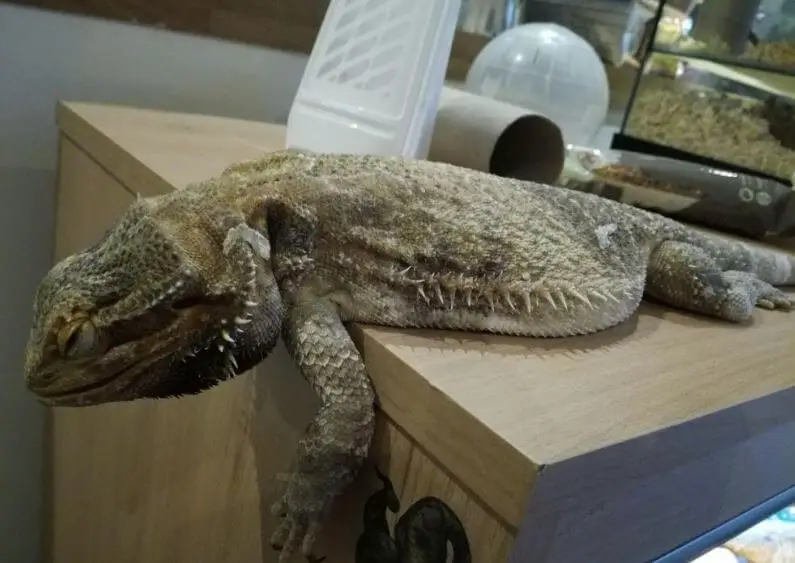Recently, some owners have asked me what the typical bearded dragon dying signs are.
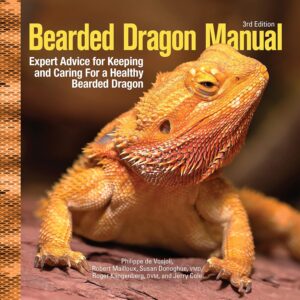 Although beardies are pretty gentle and cute pets, they also require more care than others like cats or dogs. For example, even a small change in temperature leads to a considerable threat to the cold-blooded reptile.
Although beardies are pretty gentle and cute pets, they also require more care than others like cats or dogs. For example, even a small change in temperature leads to a considerable threat to the cold-blooded reptile.
As a result, noticing bearded dragon dying signs is crucial so that you can take him to a professional veterinarian right away!
Related Posts:
- Fancy Bearded Dragon vs. Bearded Dragon: Which One Is the Best?
- How High Can Bearded Dragons Jump and How to Keep Them Safe?
- How Often to Trim Bearded Dragon Nails? A Detailed Guide
- Can a Bearded Dragon Survive Outside? Detailed Guidelines and Useful Tips
- Bearded Dragon Teeth Care? What Do You Know About It?
- Reasons Why Your Bearded Dragon Turned White and Died
- Why Is a Bearded Dragon Trying to Escape His Cage?
What Are Bearded Dragon Dying Signs?
What are bearded dragon dying signs?
When bearded dragons come near death, he shows many signs. For instance, you might notice he has unusual movement, and he always shows dull behaviors, even with your touch.
Plus, bearded dragons often lose their appetite and flood unnatural colors on their skin and eyes.
Their pooping times decrease. Other signs are loss of weight, staying in cold areas, partially-opened eyes, and no breathing.
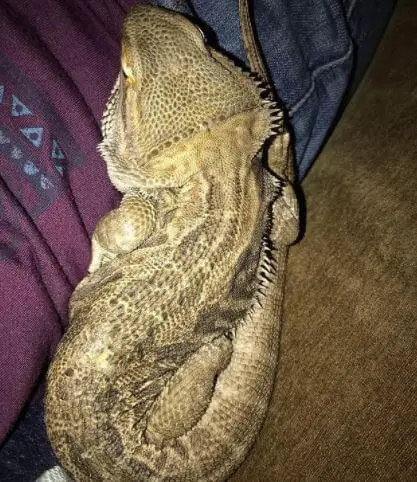
8 Bearded Dragon Dying Signs You Need to Know
1. Abnormal Movement
The first sign you will see in a dying bearded dragon is the unusual movement. It looks like he has just fallen off from a high position in his cage, and the injury would get worse over time.
However, if you still notice your pet keeps walking or moving awkwardly in a few days, metabolic bone disease might be the problem. The sickness comes from a severe lack of calcium.
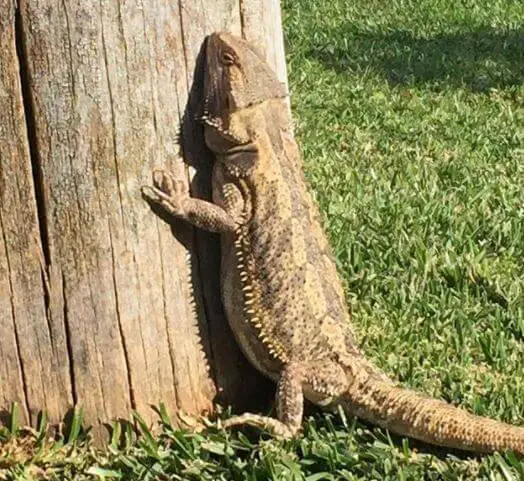
To make sure which reason is valid, you can let the veterinarian check him. With the modern X-ray method, your bearded dragon’s legs would be examined in a minute.
 After that, if the injury is caused by a branch or high accessories in your pet’s shelter, the vet would know what exactly should be done.
After that, if the injury is caused by a branch or high accessories in your pet’s shelter, the vet would know what exactly should be done.
On the other hand, if that is the dying sign, you should quickly add more calcium to his diet. Plus, vitamin D3 is also suitable for his health.
2. Unresponsive to Physical Touch
A bearded dragon is a curious and sensitive animal.
Therefore, whenever any strange stuff touched him, he would quickly run or at least move away.
However, suppose that you recently provided frequent stimuli to your pet but he does not show any response, that might be an illness sign.
Not replying happens when bearded dragons are in brumation seasons or shedding. Like snakes or bears, the reptile rarely reacts to unimportant stimuli.
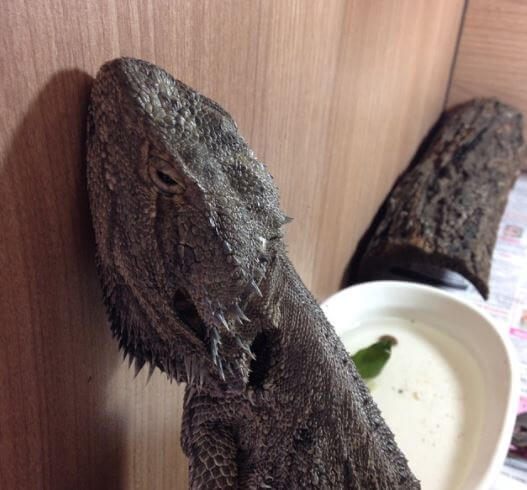
By contrast, if that is not his brumation time and he is still lethargic, you should quickly check the environmental conditions.
The wrong lighting level and temperature are mostly the culprits of the case. Then, adjust the factors to the average degree again.
Another reason for his lethargy is the underlying disease. For example, the metabolic bone disease also causes this behavior.
3. Infected Skin
When a bearded dragon lives in a dry and dirty cage for a long time, his dedicated skin would be infected. That is a signal of the bearded dragon dying.
For more details, there are discolored patches on the skin, especially near his mouth. Besides, swelling and inflammation would appear, coming with open wounds.
The fungus infection is the reason for the phenomenon.
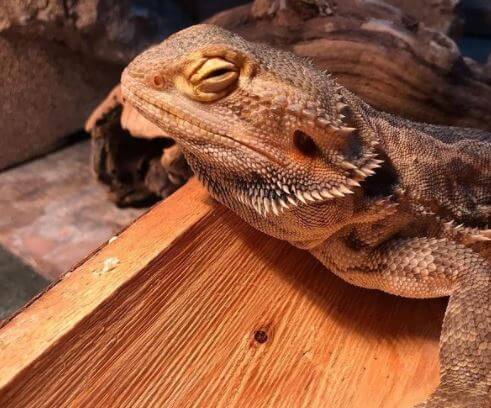
To treat the disease, take him to the vet immediately. Some kinds of antibiotics are used explicitly for the animal’s infection.
If you keep the disease from spreading for such an extended period, there may be a chance that the veterinarian can not help your beardie.
4. Less Pooping
A bearded dragon often poops once every one or two days. However, if your pet is dehydrated, he would suffer the impaction.
That being said, his body lacks water, so his intestine cannot digest food.
If you do not find out the problem and treat it soon, your bearded dragon will mostly die.
However, once you notice the impaction soon and give him the proper cure, he will overcome it soon.
For instance, you can add more water to his ration. Alternatively, bathing your pet in warm water would increase his body’s hydration.
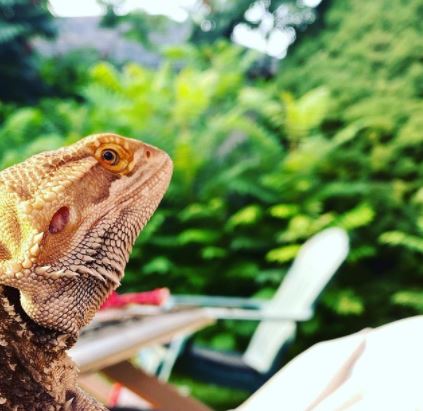
5. No Breathing
Does your bearded dragon have a shallow breath or even stop breathing for a second?
That is a symptom of respiratory problems.
Do not panic. Instead, try to find out the culprit in the level of his tank’s humidity and temperature.
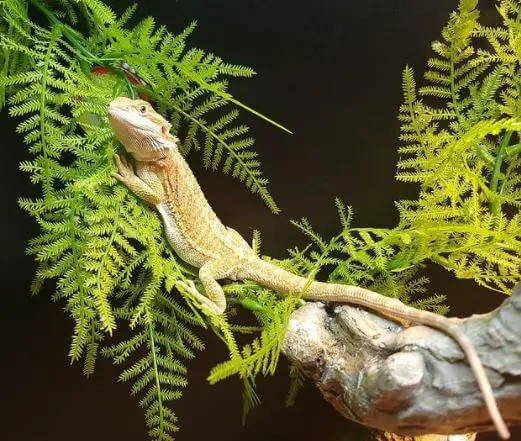
Most of the pet’s issues have roots from the too-high level of humidity and decreased heat.
Especially when he finds difficulty in breathing, he often wants to escape from the present environment.
Consider changing into a better tank. Besides, immediately have him diagnosed by a vet. If not, you can lose your pet forever.
6. Weight Loss
Another straightforward way that indicates your bearded dragon is dying is his loss of appetite, leading to considerable weight loss.
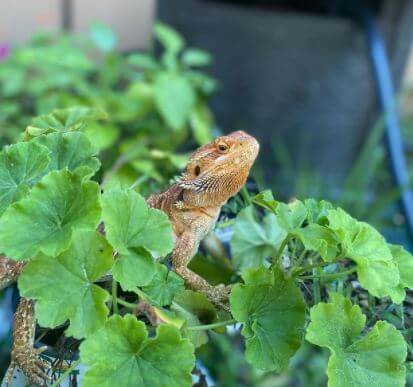
There are many reasons for his poor appetite.
First, he might get sick because of the abnormal heat in his enclosure.
Like other cold-blooded animals, his ability to digest has a close link with the temperature. If the environment is not warm enough, he can not eat well.
I recommend some thermostats to set the heat in your beardie’s tank automatically:
- BN-LINK Digital Heat Mat Thermostat Controller
- KEBIDU Digital Temperature Controller Reptile Thermostat
- OPULENT SYSTEMS Digital Controller Thermostat
Moreover, if your beardie has just come to the new house, it takes time for him to become familiar. There might be a stressful period but it does not last long.
Plus, you do not have to be worried if that is the case.
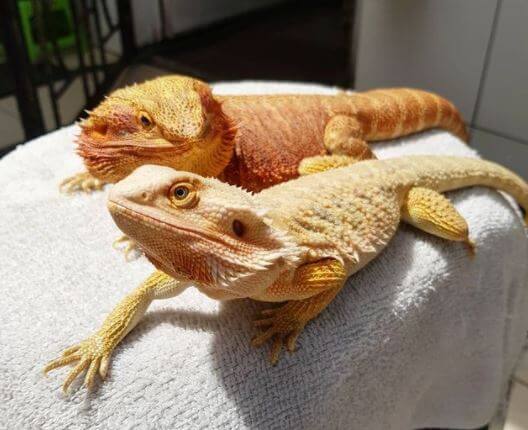
Thirdly, check the UVB light as well. When the light is not suitable, that also makes your pet feel annoyed. His clock’s body also is affected, making the intestine not function well.
However, the change would likely not be a threat to your beardie’s life.
7. Staying in the Cold Areas
A beardie dragon’s body depends on the environment’s temperature. Neither too cold nor too hot is suitable for his health.
Consequently, when you notice your pet always staying in the cold areas in his enclosure, that means his health is threatened.
For more details, a beardie’s shelter often contains two sides: the warm and the cool, and a basking spot. In each place, there are slight differences in temperatures.
While the heat can fluctuate between days and nights, it often ranges to certain degrees most of the time.
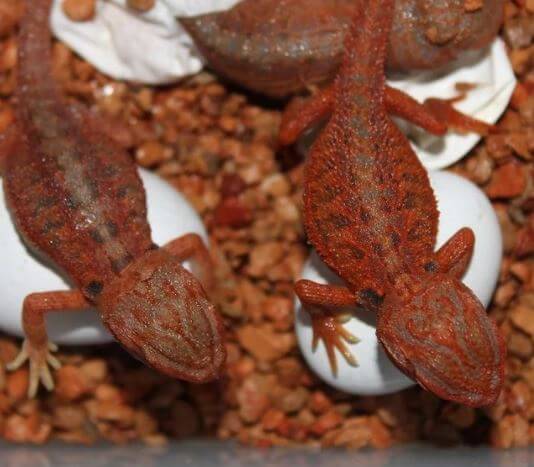
Hence, when a beardie feels the temperature in the enclosure is too low, he tends to bask more than usual or stay on the hot side all day.
However, if you notice your pet prefers the dark and cold end, the heat might become too high, compared to his body’s requirement.
For some, they even dig their burrow or hide under the shades of accessories in the tank. The abnormal heat is an enormous danger to bearded dragons.
Ideally, you should adjust the temperature to a degree between 75°F to 85°F. Either lower or higher will harm your pet, and the bearded dragon may randomly die.
8. Eyes Partially Closed
Not only do bearded dragons need a suitable temperature, but they also require a clean place so they would not be infected by any bacteria or viruses.
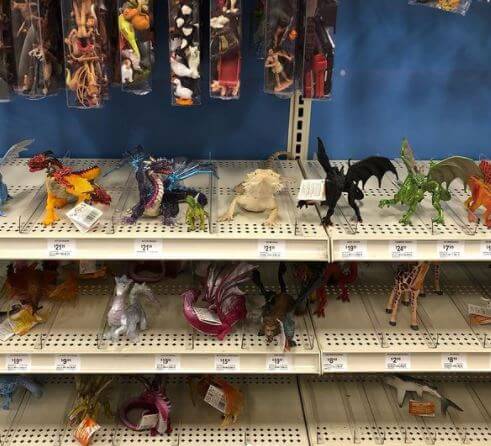
However, if they are, you might see his body give cautions about the dirty cage by some signs, such as the eyes’ discharge.
More dangerously, his eyes would not be bright and clear anymore. Instead, they partially close, sunken, or droopy.
That is the time to take him to the vet and receive an accurate diagnosis.
Some experienced owners share a tip to treat the disease: clean the cage and give him more water simultaneously. Moreover, eye drops may be helpful.
Besides the above symptoms, I see some other signals in a few pets, such as bloody poops or discolored stomachs.
Take a look at this video to know more about bearded dragon dying signs:
However, no matter what those signals are, the most important thing is to treat the disease in time.
Overall, that is just a sign, which does not mean he will die. Taking him to the vet and remedying the sickness will help.
Moreover, bear in mind to keep records of the bearded dragons’ heath and have close examinations regularly to prevent any deadly illness.
What Causes a Bearded Dragon to Die?
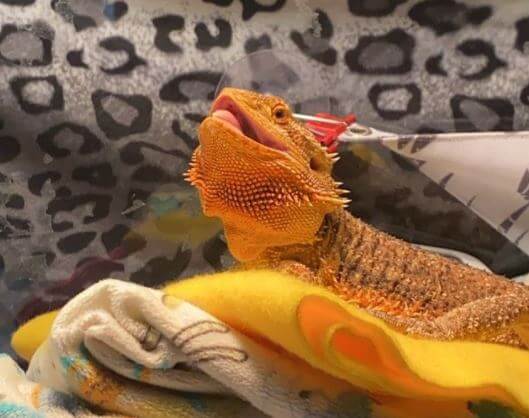
Many reasons lead to the bearded dragons’ death. That might have been caused by infection, parasites, stress, organ failures, diseases, etc.
However, after much research and tests, I found three key points ending the pet’s life: the wrong care, sickness, and old age.
1. Wrong Care
When you take a beardie from his natural environment into a strange, small cage and feed him as your pet, you need to take the whole responsibility for his health as well.
That is to say, if you do not pay enough attention to him, he would not be able to survive.
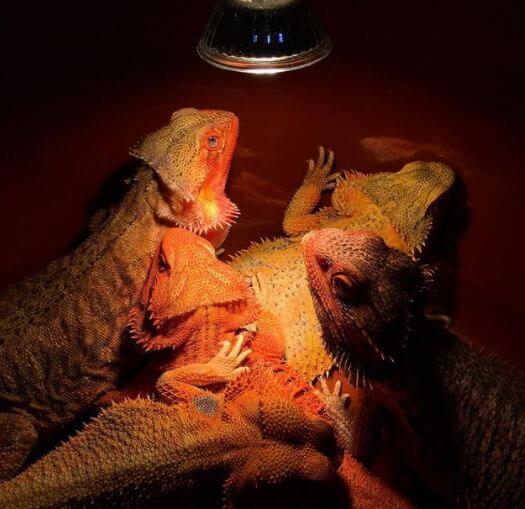
For more detail, prioritize the tank’s temperature, light, humidity, and size for the best result. Cold-blooded animals can not bear either burning or freezing environments.
Furthermore, the loose substrate would likely make your pet get impaction, the main culprit causing a quick death.
Plus, do not feed him too many insects. Adding more water and live plants to his meal would help.
2. Sickness
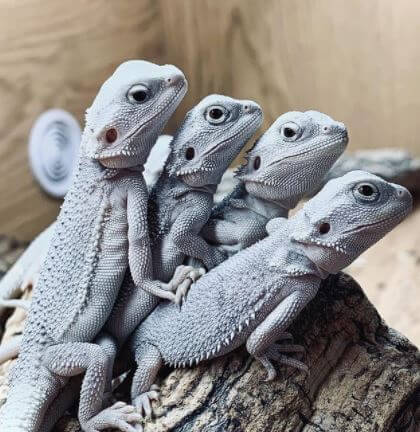
The second reason that explains the beardie’s death is the sickness. Some prevalent diseases seen in the dragon are metabolic bone disease, parasite infection, or dehydration.
With each issue, your pet needs the proper treatment. Therefore, if you are unsure what problem he has and how to solve it, take him to the vet immediately.
The longer you wait for the sickness to develop, the less chance your pet can be alive.
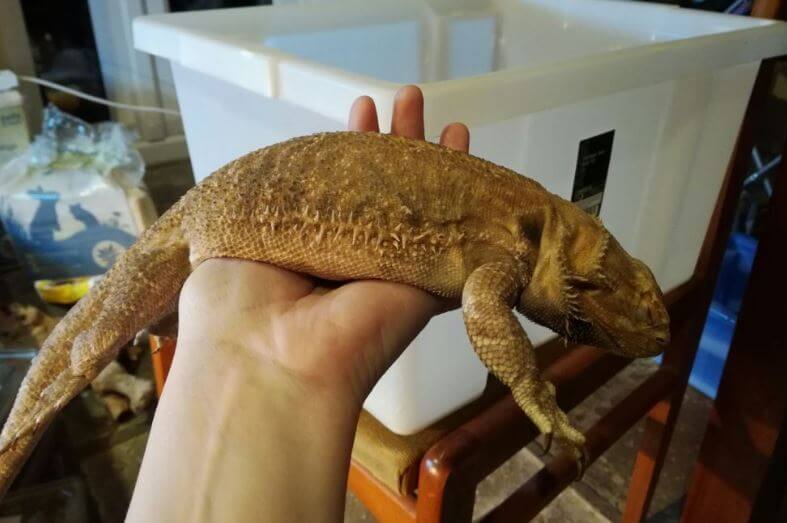
3. Old Age
Last but not least is old age. Similar to any living creature, bearded dragons have a limited live period.
Often, an average beardie’s life ranges from 10 to 15 years in captivity conditions.
However, when they are eight to nine years old, they are at an old age. That’s when they move slowlier, eat less, sleep more, and have less curiosity.
Symptoms of aneurysms or organ failures might appear alike.
Because you can not control his life cycle, accepting it is your only choice. Then, take care of him more carefully, and notice if he needs anything before coming to the end of his life.
Frequently Asked Questions About Bearded Dragon Dying Signs
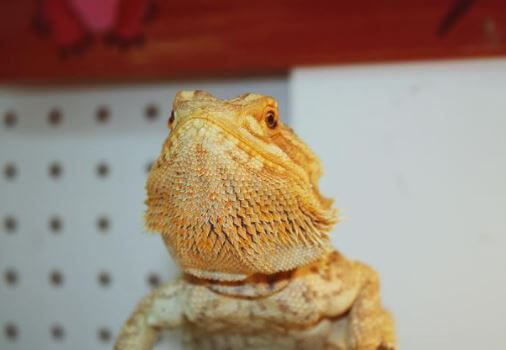
1. How Can You Tell If a Bearded Dragon Is Dying or Hibernating?
To figure out if your bearded dragon is dying or hibernating, you can do a quick test.
First, lay him on his side. If he does not move, that might be a signal of dying.
To be more sure, try to turn him onto his back.
Even the laziest dragon feels uncomfortable with the position, and he would wiggle upright.
If not, I have to say your bearded dragon is about to die.
2. Can Metabolic Bone Disease (MBD) Kill Bearded Dragons?
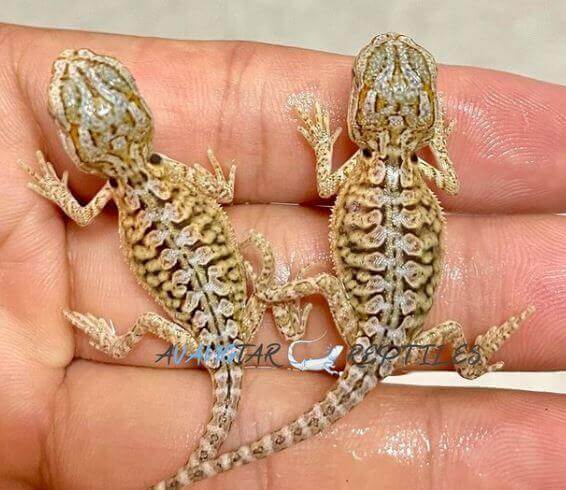
In actuality, metabolic bone disease is a considerable danger to the bearded dragons’ lives if you do not realize and treat it soon.
Not only is it itchy, but it also forces your pet to get weaker over time. However, if you take him to the vet and give him the right cure, he can overcome the sickness.
Besides, to prevent it, you should improve his tank’s condition by adjusting the suitable temperature, light, and humidity, and by giving him the proper supplements.
3. Can Bearded Dragons Come Back to Life From the Dead?
It mainly depends on the current health of your bearded dragon and your care.
For instance, a few of my friends reported that their bearded dragon died and came back to life because they gave them an accurate healing.
However, for some, they can not resolve their pet’s problem soon, leaving them to die due to such simple reasons as a too-high temperature or lack of water.
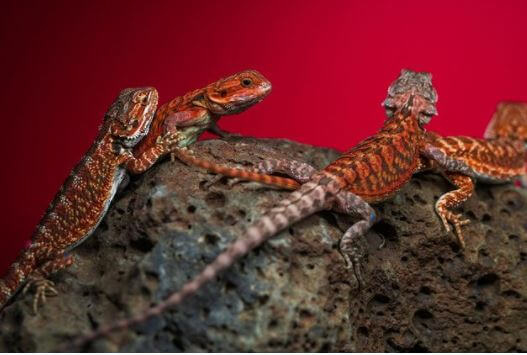
4. How to Dispose of Dead Bearded Dragons?
The first step to dispose of a dead bearded dragon is to let go of his body.
You can consider burial or cremation.
If you opt for cremating, call for the vet’s help or pay for a pet cremation service.
Then, pack away the bearded dragon’s tank and accessories. Think about paying tribute at his funeral.
Conclusion
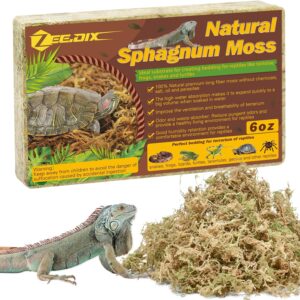 In summary, the above are critical pieces of information related to the bearded dragon dying signs.
In summary, the above are critical pieces of information related to the bearded dragon dying signs.
There are a few clear signals you can notice, including abnormal movement and no reply to the physical touches.
More importantly, your pet is dying when he eats less, losses weight with pooping problems, and other issues.
The main reasons why bearded dragons die are old age, illness, or improper care.
With the symptoms and causes, taking the dragons to the vet and giving them the proper treatment might help them come back to life.
Key points about bearded dragon signs of dying:
Bearded dragons are hardy reptiles, but like any pet, they can face health issues that may eventually lead to the end of their life. It’s crucial for owners to recognize the signs of a dying bearded dragon to provide appropriate care and support during this challenging time. Here are key indicators to be aware of:
1. Drastic Changes in Behavior:
- Unusual lethargy and a significant reduction in activity levels can be a sign that a bearded dragon is not well.
2. Loss of Appetite:
- Refusal to eat, even when offered their favorite foods, is a concerning sign.
- This can lead to weight loss and a weakened immune system.
3. Weight Loss:
- Bearded dragons may rapidly lose weight as their health deteriorates.
- A noticeable decrease in body weight is a distressing indicator.
4. Sunken Eyes:
- Sunken or dull-looking eyes can be a sign of dehydration and malnutrition.
5. Changes in Coloration:
- Abnormal color changes, such as darkened skin or a noticeable paleness, can signal distress or illness.
6. Difficulty Breathing:
- Wheezing, labored breathing, or open-mouth breathing are signs of respiratory issues.
- Breathing difficulties can be indicative of severe health problems.
7. Loss of Balance:
- A bearded dragon that struggles to maintain balance or coordination may be experiencing neurological or metabolic issues.
8. Seizures or Tremors:
- Uncontrolled movements or seizures are a cause for immediate concern.
- They can be a sign of neurological problems or other underlying illnesses.
9. Swelling or Bloating:
- Abdominal swelling or bloating can indicate digestive problems or organ issues.
- It may be accompanied by discomfort or pain.
10. Infections or Sores:
- Open wounds, abscesses, or visible infections should not be ignored.
- They can be a result of weakened immune function.
11. Reduced Responsiveness:
- A bearded dragon that no longer responds to stimuli, such as touch or environmental changes, may be near the end of its life.
12. Cloaca Problems:
- Bearded dragons that have difficulty defecating or laying eggs may require immediate veterinary attention.
- Cloacal issues can be life-threatening.
13. Shivering or Prolonged Coldness:
- A bearded dragon that shivers or remains unusually cold may be in a state of distress.
- Inadequate warmth can exacerbate their condition.
14. Prolonged Illness:
- If your bearded dragon has been suffering from a chronic illness that is not improving despite treatment, it may be a sign that their condition is worsening.
When you observe multiple signs of a dying bearded dragon, it’s vital to seek immediate veterinary care. A reptile-experienced veterinarian can provide a proper diagnosis and guidance on the most compassionate and appropriate course of action. While it can be a difficult and emotional time for any owner, recognizing these signs and taking action promptly is essential to ensure the comfort and well-being of your beloved bearded dragon.
Further Reading:
- Carolina Custom Cages Terrarium Review
- 8 Best Basking Rocks for Beardie: What Is the Best Choice?
- 10 Best Thermometers for Beardie: How to Choose the Best One?
- 5 Best Beardie Lighting Setups for Beardie Lovers
- 9 Best Heat Lamps for Beardie: Natural Habitat Provided

